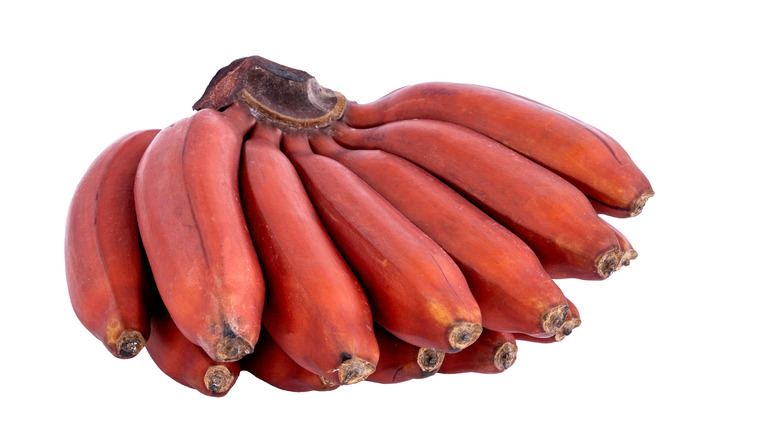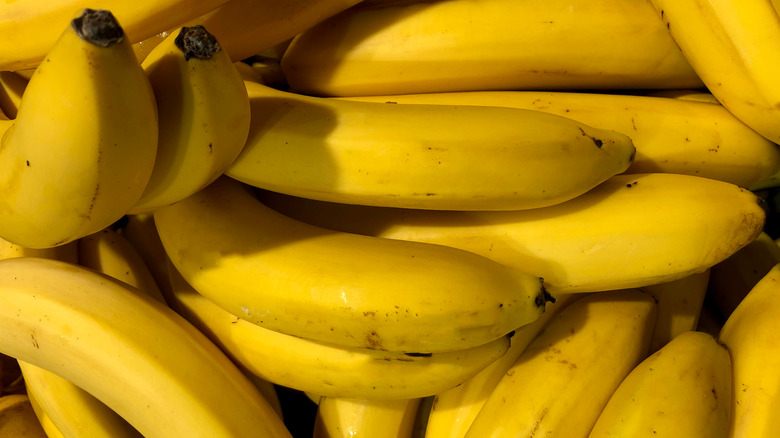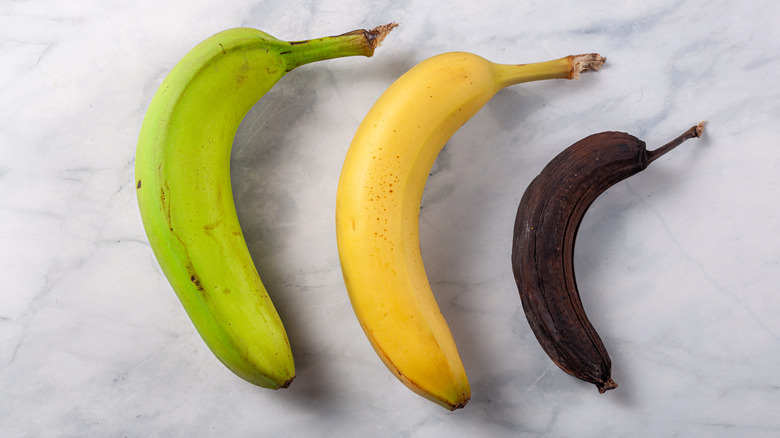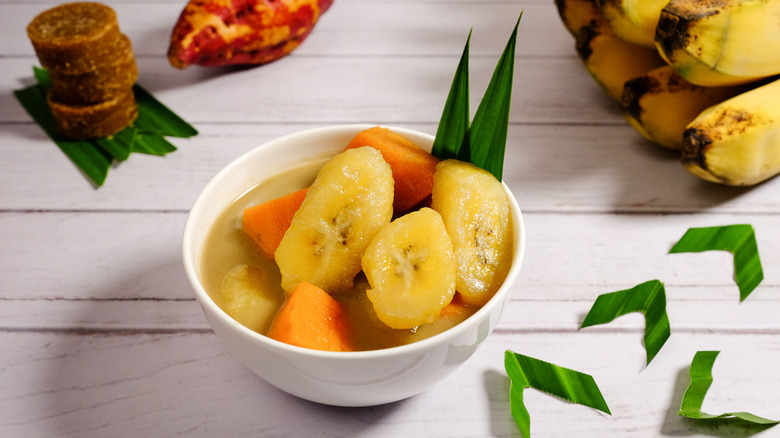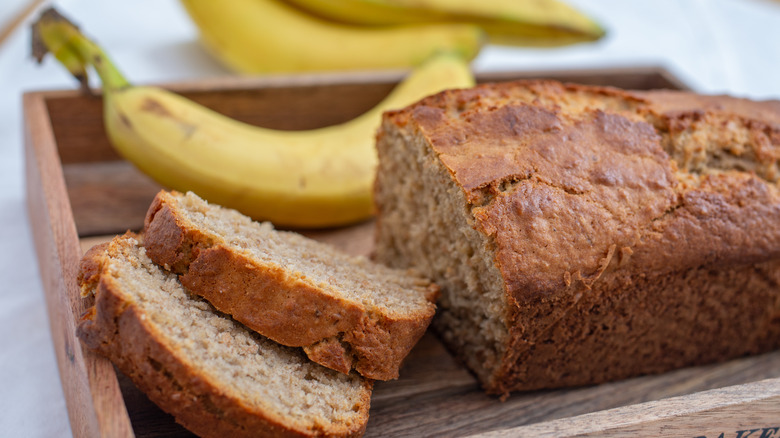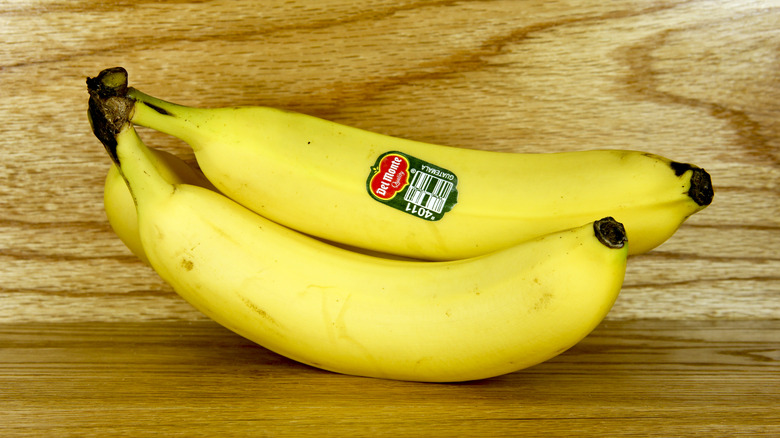The Real Difference Between Red And Yellow Bananas
We love bananas. They're a great source of potassium, are naturally sweet, and easy to have on the go. We love to have them on top of pancakes, in bread, and even as a candy flavor.
They are usually easy to spot in the produce section of most supermarkets, grouped together in pods called "hands" or sometimes alone as "fingers" (via Best Food Facts). According to The Rainforest Alliance, these bananas are called Cavendish bananas and are very popular in North America and Europe.
But have you heard about red bananas, let alone, know about them? Probably not. They're smaller than yellow bananas and originated from Southeast Asia, according to Healthline. The red banana is one of over 1,000 subgroups of bananas, which includes the Cavendish banana that we know and love.
But what if you're trying to see how these two varieties stack up against one another? Let's explore some differences between the two.
What are bananas really?
According to the San Diego Zoo, a banana plant is actually a giant herb instead of a tree, which is a common misconception. Another misunderstanding about this popular fruit is that they need to be produced in countries located in the tropics. While this is mainly true, the Icelandic Agriculture University has a tropical greenhouse where bananas are grown, according to Iceland Magazine. Bananas are actually grown in 150 countries and are the world's most traded fruit, per BananaLink.
Bananas actually started off as a luxury food for Americans, as one variety, the Gros Michel, was imported from Jamaican plantations in the 1880s and '90s by businessmen Andrew Preston and Minor Cooper Keith. The fruit's nutritional benefits were then greatly marketed, causing an increase in popularity during this era, according to Vox. The report also details how bananas became standardized, lowering their cost and increasing their production through cloning, which is why we have so many bananas today.
Difference in flavor and appearance
We all know bananas are naturally sweet. However, their sweetness comes without having a glycemic index that is too high, so diabetics can't enjoy them in moderation, according to Medical News Today. Yellow bananas usually start off green, which is when they are the least sweet, then slowly yellowing and turning brown over a period of days. Riper bananas are more sweet because the starch turns into sugar, according to Oprah.com.
Red bananas are the same way, in that they grow sweeter the more ripe they are. A premature red banana can taste dry, according to Specialty Produce. Healthline describes their mature taste as very similar to yellow bananas, with a "hint of raspberry sweetness." They are also known to be softer and creamier, almost "like a dessert," according to Thrive Cuisine. Despite being labeled "red," these bananas take on a more reddish-purplish tone, according to Harvard T.H. Chan School of Public Health. They are also notably wider and shorter than yellow bananas.
Difference in nutrition
As mentioned before, bananas are a great sweet snack or breakfast item that doesn't significantly spike blood sugar. This is because bananas are also full of fiber, which slows digestion, according to Healthline. Additionally, they are great for your cardiovascular health, digestive health, and weight control, according to Harvard T.H. Chan School of Public Health.
Since they are both Musa species, according to a ResearchGate article, red bananas and yellow bananas are fairly similar in nutritional value. One red banana finger is around 90 calories and one yellow banana finger is roughly 105 calories, according to Healthline.
However, red bananas are especially good for eye health, due to the carotenoids in the red pigment (via Healthline). The same article states that red bananas also have more vitamin C and a lower glycemic index score than their more common counterparts. More reasons to go out and try this colorful variety!
Can you substitute red and yellow bananas in recipes?
Yes, you can swap out red and yellow bananas in recipes! As mentioned before, red bananas are very similar in taste to yellow bananas, except that they have a slight berry-like taste. They can be used in banana bread, but also in smoothies, oatmeal, and ice cream, according to Healthline. They can also be enjoyed in dishes such as red banana chicken (via Better Homes & Gardens), which is the ultimate combination of sweet and savory.
With red and yellow bananas pretty similar in nutritional content, you can pretty much swap them out 1:1 — just be mindful of the more creamy texture and added "raspberry" flavor. Stylecraze also states that red bananas are great in hair and skincare because of the vitamin C content, so if you're a beauty guru or just want to experience the amazing, antioxidants of this lesser-known banana, try whipping up a detoxing face mask using it as an ingredient!
Where to buy red bananas
Red bananas are a little harder to find than their yellow cousins, but surprisingly, major retailers like Whole Foods do sell them. Furthermore, a lot of big yellow banana brands like Dole, Del Monte, and Chiquita sell them, according to Eat Like No One Else, so see if you can find them in your local supermarket. The writer of the blog stated that he got some for 39 cents a pound, which is potentially cheaper than a pound of yellow bananas at Walmart.
However, if you can't seem to find them in a grocery store near you, Miami Fruit and Melissa's are some websites that sell red bananas and will ship them to your house. Just a heads-up — one pack from each retailer is likely higher than a local grocery store. But if you're willing to pay that price, you'll have a box of sweet, creamy fruit that is both healthy and delicious.
